Related Research Articles
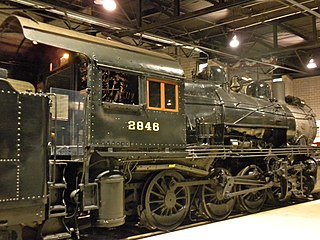
The Pennsylvania Railroad's class H6, H6a, and H6b steam locomotives were of the 2-8-0 "Consolidation" freight type, the most numerous class on the railroad with 1,707 units and the second most prolific 2-8-0 class in North America, with the USATC S160 class rostering 88 units more. The three subclasses differed as follows:

The Chosen Government Railway was a state-owned railway company in Korea under Japanese rule. It was a department of the Railway Bureau of the Government-General of Korea, whose functions were the management and operation of railways in Korea, as well as the supervision of privately owned railway companies.

The China Railways JF6 class steam locomotive was a class of 2-8-2 steam locomotives for freight trains operated by the China Railway. They were originally built in Japan and Manchukuo between 1934 and 1944 for the South Manchuria Railway (Mantetsu), the Manchukuo National Railway, and the North China Transportation Company.

The China Railways SL6 class steam locomotive was a class of 4-6-2 superheated two-cylinder passenger steam locomotives operated by the China Railway. Originally built for the South Manchuria Railway (Mantetsu), the Manchukuo National Railway, the Central China Railway and the North China Transportation Company by several Japanese manufacturers between 1934 and 1940, they were the most numerous class of steam passenger locomotive in China, with 422 eventually built.
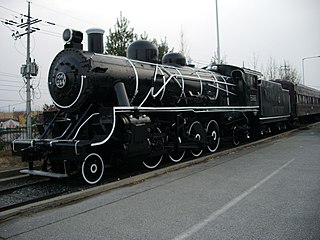
The Mika type was made up of four distinct classes of steam tender locomotives of the Chosen Government Railway (Sentetsu) with 2-8-2 wheel arrangement. The "Mika" name came from the American naming system for steam locomotives, under which locomotives with 2-8-2 wheel arrangement were called "Mikado" in honour of the Emperor of Japan, as the first 2-8-2 locomotives in the world were built for Japan.
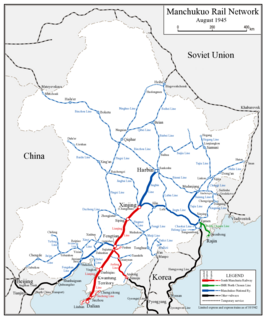
The Manchukuo National Railway was the state-owned national railway company of Manchukuo. Generally called the "國線", it was controlled by the Manchukuo Ministry of Transportation and had its lines primarily in the central and northern parts of the country. In local newspapers it was simply referred to as "國鉄"

The China Railways SL11 class steam locomotive was a class of 4-6-2 passenger steam locomotives operated by the China Railway. They were originally built for the South Manchuria Railway and the Manchukuo National Railway by ALCO of the United States in 1908, and have the distinction of being part of the first group of standard gauge locomotives to operate in northeastern China.

The China Railways SL3 class steam locomotive was a class of 4-6-2 passenger steam locomotives operated by the China Railway. They were originally built for the South Manchuria Railway, the Manchukuo National Railway and the North China Transportation Company by several Japanese manufacturers between 1934 and 1940. They were designed in 1933 based on the design of the first Pashisa class locomotives ; the first order was placed by Mantetsu in March of that year.
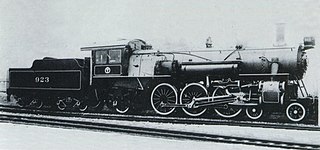
The China Railways SL4 class steam locomotive was a class of 4-6-2 passenger steam locomotives operated by the China Railway. They were originally built for South Manchuria Railway (Mantetsu), where they were designated Pashishi (パシニ) class. Mantetsu's 1938 "Pashishi" classification was made up of two distinct classes of locomotive, the former G2 and G3 classes, built in 1919 and 1921 respectively, for Mantetsu and for the Manchukuo National Railway.

The China Railways SL8 class steam locomotive was a class of 4-6-2 express passenger steam locomotives operated by the China Railway. They were originally built for the South Manchuria Railway (Mantetsu) and the Manchukuo National Railway between 1937 and 1940.

The China Railways AM1 class locomotives were a class of 4-4-0 passenger steam locomotives operated by the China Railway, originally built for the South Manchuria Railway (Mantetsu). The "Ame" name came from the American naming system for steam locomotives, under which locomotives with 4-4-0 wheel arrangement were called "American".
The China Railways TH10 class steam locomotive was a class of 4-6-0 passenger steam locomotives operated by the China Railway. Originally amongst the first locomotives ordered by the South Manchuria Railway (Mantetsu), they were later operated by the privately owned Jichang Jidun Railway and its successor, the Manchukuo National Railway, which designated them Tehoni class. The "Teho" name came from the American naming system for steam locomotives, under which locomotives with 4-6-0 wheel arrangement were called "Ten-Wheeler".

The China Railways TH1 class steam locomotive was a class of 4-6-0 passenger steam locomotives operated by the China Railway. Originally built for the South Manchuria Railway (Mantetsu), some were also operated by the Manchukuo National Railway. The "Teho" name came from the American naming system for steam locomotives, under which locomotives with 4-6-0 wheel arrangement were called "Ten-Wheeler".

The China Railways LD1 class steam locomotive was a class of streamlined 4-4-4T tank steam locomotives for passenger trains operated by the China Railway. They were originally built for the South Manchuria Railway (Mantetsu) in 1936. The "Dabu" name came from the English "double-ender", which was used by Mantetsu for all tank locomotives.

The China Railways MT1 class steam locomotive was a class of 4-8-2 steam locomotives for goods trains operated by the China Railway. They were originally built for the South Manchuria Railway (Mantetsu) in Japan in 1936. The "Mate" name came from the American naming system for steam locomotives, under which locomotives with 4-8-2 wheel arrangement were called "Mountain".
The China Railways KD23 class locomotive was a class of 2-8-0 steam locomotives operated by the China Railway. Originally amongst the first locomotives ordered by the South Manchuria Railway (Mantetsu), they were built by ALCo of the United States in 1906, and they were later operated by the privately owned Jichang Jidun Railway and its successor, the Manchukuo National Railway. The "Sori" name comes from the American naming system for steam locomotives, in which the 2-8-0 wheel arrangement is called "Consolidation".
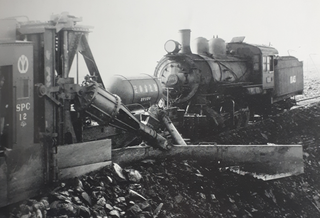
The China Railways KD1 class locomotives were a class of 2-8-0 steam locomotives operated by China Railway, originally built for the South Manchuria Railway (Mantetsu) and the Manchukuo National Railway by ALCo of the United States in 1907 and 1908. The "Sori" name comes from the American naming system for steam locomotives, in which the 2-8-0 wheel arrangement is called "Consolidation".
The South Manchuria Railway operated a wide variety of locomotives and powered railcars, as well as non-powered passenger and freight cars, initially of foreign manufacture, but later almost all equipment was manufactured in Japan and Manchukuo.
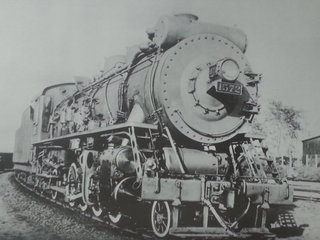
The China Railways JF1 class steam locomotive was a class of 2-8-2 steam locomotives for freight trains operated by the China Railway. They were originally built in the United States, Japan and Manchukuo between 1918 and 1945 for the South Manchuria Railway (Mantetsu), the Manchukuo National Railway, the North China Transportation Company, and the Central China Railway. After the end of the Pacific War, they were taken over by the China Railway, the Korean State Railway in North Korea and by the Korean National Railroad in South Korea, and more were built in China after 1949 for the China Railway, which ultimately operated over 2,000 of the type.

The Purena-class (プレナ) locomotives were a group of steam tank locomotives with 2-6-2 wheel arrangement of used by the Chosen Government Railway (Sentetsu) in Korea. The "Pure" name came from the American naming system for steam locomotives, under which locomotives with 2-6-2 wheel arrangement were called "Prairie".